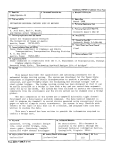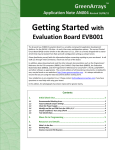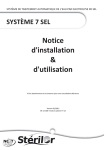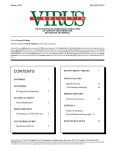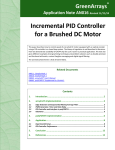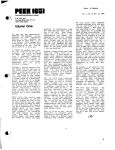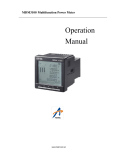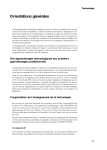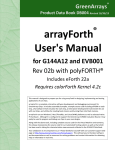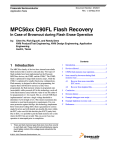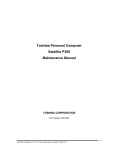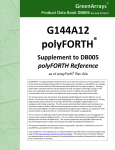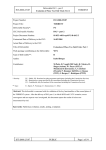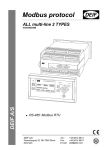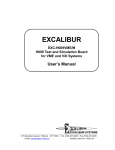Download AN001
Transcript
GreenArrays ® AN001 MD5 Application Note AN001 Revised 10/23/14 Implementing MD5 on a GA144 MD5 is a well known cryptographic algorithm, calculating a one way hash function of 128 bits on an arbitrarily long sequence of octets; it is a standard component of many cryptosystems including IPSec and Public Key Infrastructures. There are many possible ways to implement such an algorithm on GreenArrays chips; the implementation described in the first part of this document is the first we have produced (written by staff member Charley Shattuck) and is written as machine code for a cluster of F18 computers. This method generally leads to maximum speed, no dependency on external memory or high level programming such as eForth, and may be adapted for commitment to ROM if desired. In this paper we describe the operation of the module and its interfaces. The text assumes you have familiarized yourself with our hardware and software technology by reading our other documents on those topics. The current editions of all GreenArrays documents, including this one, may be found on our website at http://www.greenarraychips.com . It is always advisable to ensure that you are using the latest documents before starting work. Contents 1. Overview .......................................................................................................................................... 2 1.1 Data Sources ........................................................................................................................................................................................ 2 2. Green Arrays Architecture ................................................................................................................ 3 2.1 2.2 2.3 32 Bit Addition and Rotation ............................................................................................................................................................... 3 A Lookup Table with 64 32 bit Words .................................................................................................................................................. 3 Other Code and Data ........................................................................................................................................................................... 3 3. Data Flow Block Diagram .................................................................................................................. 4 4. Allocation of Code and Data for MD5 ................................................................................................ 4 4.1 4.2 4.3 32 Bit Operations in 16 Bit Halves ....................................................................................................................................................... 4 Layout .................................................................................................................................................................................................. 5 Beginning and Ending the Application ................................................................................................................................................ 5 5. Discussion of the details ................................................................................................................... 6 5.1 5.2 5.3 5.4 5.5 5.6 5.7 5.8 5.9 5.10 5.11 Main Load Block .................................................................................................................................................................................. 6 Boot Descriptors .................................................................................................................................................................................. 7 Table Lookup ....................................................................................................................................................................................... 7 Adding and Rotating 32 Bit Words ...................................................................................................................................................... 9 Digest Buffer and the Four Functions ................................................................................................................................................ 10 Message Buffer.................................................................................................................................................................................. 11 Calculating the Amount of Rotation.......................................................................................................................................... 11 Initial Digest Buffer and Summation ................................................................................................................................................. 12 Getting a Hash Started ...................................................................................................................................................................... 13 Formatting the Input Stream............................................................................................................................................................. 14 Application Interface ......................................................................................................................................................................... 15 6. Testing the MD5 Module using polyFORTH® ................................................................................... 16 6.1 Initiating the MD5 Hash .................................................................................................................................................................... 16 AN001 MD5 1. Overview A definitive specification for the MD5 algorithm is published by the Internet Engineering Task Force as RFC 1321 and a discussion of performance is available in RFC 1810 as well as tables in books such as Applied Cryptography by Bruce Schneier. Incidentally, our own reference FORTH implementation running on a PC with 2.9 GHz modern Intel processor hashes 1,000,000 bytes in 3.782 milliseconds for a hash speed of 2.12 gigabits per second. MD5 presents a few problems for programming a Green Arrays device. For one thing it depends on modulo 32 bit addition and rotation. Green Arrays chips deal in 18 bit quantities. For another, md5 is complicated enough that neither the code nor the set of constants required to implement the algorithm will fit into one or even two or three nodes of a Green Arrays computer. Let's see how to deal with that. 1.1 Data Sources During each step of the MD5 algorithm there are three main sources of data and several numerical sequences for accessing this data. The first data source is the current state of the message digest, represented as ABCD. It contains 4 32 bit numbers. Temporary storage for A, B, C, and D is required as well. Let's call that AA, BB, CC, and DD, each a 32 bit number. ABCD is accessed in rotating fashion as ABCD, DABC, CDAB, BCDA, and so on as the algorithm proceeds. The second data source is the message buffer, represented by X(k). The message is divided into blocks of 64 bytes or 16 32 bit words, indexed by the sequence represented by k. The message buffer is accessed in an order that is not linear, but which can be calculated in less space than it can be listed in. The third data source is 64 32 bit word constants in a table represented by T(i). These constants are accessed in a linear fashion via the index i. Finally there is a sequence of 64 numbers representing a rotation amount, called s. This sequence can also be calculated in less space than would be required to list it. There are four bitwise functions applied to the ABCD data. They are called f', g', h', and i' where: f'(X, Y, Z) = (X and Y) ior (not(X) and Z) g'(X, Y, Z) = (X and Z) ior (Y and not(Z)) h'(X, Y, Z) = (X xor Y) xor Z i'(X, Y, Z) = Y xor (X ior not(Z)) Note that ior (inclusive or) and xor (exclusive or) are spelled out in order to be perfectly clear. Let abcd represent the current rotation of ABCD, DABC, CDAB, or BCDA. Let "function" stand for one of the four functions listed above. Using the other symbols also introduced above this is how the 64 operations for each message buffer will look: a := b + (rotate ( s, (a + function(bcd) + X(k) + T(i)))) We’ll soon see how such an equation can be implemented as a cluster of F18 nodes. 2 Copyright© 2010-2013 GreenArrays, Inc. 10/23/14 AN001 MD5 2. Green Arrays Architecture A couple of things about the Green Arrays architecture dominate this implementation of MD5. One is the fact that MD5 is a 32 bit algorithm and GA architecture is 18 bits. The other is that each node of a Green Arrays chip is limited to 64 18 bit words of memory for both program and data. To address the first item we will perform all the 32 bit arithmetic and logic in parallel, 16 bits per partner node. For addition, carries can be accumulated in the upper two bits of the low word and communicated to the node handling the high word in time to avoid overflow. The second item is addressed by distributing program code and data among several nodes which communicate with each other. Note that the four functions specified above are bitwise functions. There is no carry to ripple and no bit rotations occur. This means that two separate nodes can independently perform the high 16 bit and low 16 bit operations without interacting. Nice. 2.1 32 Bit Addition and Rotation We've split the 32 bit numbers into 16 bits high and 16 bits low, handled by separate but adjacent nodes. The low node can add and maintain the carries for up to three additions before having to pass its two bits of carry up to the high word to be added in. 32 bit rotation can be implemented using the Green Arrays +* instruction. For example, an 18 bit rotation could be performed by putting zeros into S and A and executing +* repeatedly. The 0 in S would be added to T without changing anything and bit(s) would shift from T into A. At the end you could fetch A and or it with T to construct the rotated value. Rotating a 32 bit number is just a bit more complicated. Both the high and low words would be shifted from T into A, but this time the nodes would swap their T values before oring with A. Also the A values would be shifted right two more times via 2/ and anded with ffff before being ored with T. 2.2 A Lookup Table with 64 32 bit Words Now we've already split the high and low 16 bit word operations into separate rows of nodes. We therefore need two tables of 64 16 bit words each. We can do that using two nodes filled with all data, no code, which jump to neighbor ports to receive the code which looks up data. Once each data node has its A register initialized to zero, the data can be looked up with the simple instruction word @+ !p .. executed in its port. The .. fills the remainder of the instruction word with nops so that the next opcode will go into slot 0 of the next word. 2.3 Other Code and Data The other data buffers, ABCD and the message buffer, are smaller and can be in nodes that also contain code. One pair of nodes is pretty much dedicated to calculating the message buffer index, reading a word each from their buffers, and passing those words down the line to nodes that apply the MD5 algorithm. Since the rotation amount is the same for high word and low word, a single node can calculate this amount and pass it to both the high row and the low row. Similarly a single node buffers ABCD when a particular message block begins and adds that back in to the message digest at the end of that block's processing. One pair of nodes is pretty well occupied with the four bitwise functions but has room to also do a bit of addition before passing the sum off to another pair that handles resolving the carry, fetching and adding the constants from the lookup tables, and performing the 32 bit rotations. Copyright© 2010-2013 GreenArrays, Inc. 10/23/14 3 AN001 MD5 3. Data Flow Block Diagram In planning a multi-node application for GreenArrays chips, we think in terms of a data flow diagram. The following Figure diagrams this implementation of MD5: 4. Allocation of Code and Data for MD5 Let's describe some of the thinking that led up to this layout. After reading and understanding the md5 specification it was obvious that some sort of extended precision arithmetic and logic was needed. MD5 is a 32 bit algorithm and Green Arrays architecture is 18 bits. The first thought was to define 36 bit operators for addition and each of the four bit-oriented functions needed, as well as 32 bit rotation. Each of these was actually coded in order to see how much memory they would consume. After coding the four functions there wasn't room for much else. Each function implied having three double precision items on the stack as inputs. This occupies six stack locations leaving only four more to work with. Stack overflow was a serious possibility. In addition, watching the numbers in the simulator was difficult since they didn't line up in nibbles as 32 bit hex numbers would. 4.1 32 Bit Operations in 16 Bit Halves This problem of visibility while debugging is what inspired the idea of splitting 32 bit operations into two 16 bit operations in partner nodes. Suddenly the bit-wise functions only required three stack locations per node instead of six. The lookup tables could be split into a high 16 bit word and a low 16 bit word. Numbers being passed from node to node could easily be recognized as high or low 16 bit halves. In addition this introduced some parallel processing to an otherwise very sequential set of operations. When it comes to addition or rotation you might think that propagating the carry across nodes would waste some time and it does, but not as much as you might expect. The low partner node can accumulate carries from up to three additions before propagating it to the high partner in a single addition. 32 bit rotation can be done using the +* instruction to shift bits from T into A then sharing and oring those bits across partner nodes to achieve a 32 bit rotation with the minimum of inter-node communication. 4 Copyright© 2010-2013 GreenArrays, Inc. 10/23/14 AN001 MD5 4.2 Layout The layout of the md5 block diagram is determined to some extent by the need to have partner nodes in communication with each other for carry and rotations. The obvious layout is two rows of nodes one above the other. The block diagram shows high 16 bit nodes in the 200 row and low nodes in the 100 row. First the 64 word lookup tables were placed on the east end of the layout in nodes 215 and 115. After coding the four bit-wise functions in nodes 213 and 113 it was seen that there was still room to put the MD (Message Digest) buffer in the same node simplifying calculations. There wasn't going to be room to code the rotations in the same node, so that was put along with carry resolution and lookup code for the constant tables in 214 and 114 between the functions and the constant tables. This leaves 212 and 112 to the west of the MD buffer for the message buffer. The message buffer contains 16 32 bit words for a total of 64 bytes or octets. The high 16 bit words of the message buffer are in the high row and the low 16 bit words are of course in the low row. There is room in these nodes to calculate the index into the message buffer. Unfortunately there is not room in any of the aforementioned nodes to calculate the rotation amount, so another pair of nodes is tacked on to the west. Since both rows get the same rotation amount, it only needs to be calculated in the high row and sent down to the low row. The low member of this pair is free for other code and in fact is where the old MD is saved and later added to the new MD after a message block has been otherwise hashed. Five pairs of nodes have been mentioned so far. These nodes are active in calculating the md5 hash once the MD and message buffers have been filled. One of the western most of these nodes, 111, actually just passes the rotation amount calculated by its partner 211 during the hashing phase. Once the md5 algorithm has been applied to the whole message buffer though, this is the node that receives the new message digest and adds it to the old message digest saved there. Before starting work on a new message block this node will send the current MD values over to the pair that contain the MD buffer and functions. Nodes 214 and 114 need to be adjacent in order for carry to propagate in addition and for rotation, but 215 and 115 only need to communicate with their neighbors 214 and 114 respectively. 215 could be moved up to 314. 115 could be moved below to 014 as well. 213 and 113 don't need to talk to each other so they could move up above 214 and below 114 instead of the constant tables. Likewise 212 and 112 don't need to talk to each other, so they could be moved up and down a row too. 4.3 Beginning and Ending the Application In addition to the five pairs of nodes involved in the calculation of each round of the hash, four nodes have been added to the west which perform duties only required at the beginning and end of a hash, or the beginning and end of a message block. Nodes 210 and 110 contain code that is streamed to nearby neighbors in order to initialize the message buffer in nodes 212 and 112 and move the current message digest into its buffers in nodes 213 and 113 before starting a message block as well as giving initial values to the MD buffer at the beginning of a hash. Another pair of nodes, 209 and 109, is added to the west in order to receive each octet of the message block, assemble them into 16 bit words and distribute those to the high and low buffer nodes. 109 receives, counts and passes on message octets, pads the message buffer at the end and gets the other nodes to start their processing. 209 is the application interface. It receives message octets, a negative number signalling end of message, from the outside world and presents the message digest to the outside world when the hash has finished. Each node begins by jumping to a neighbor, waiting to be told what to do. Node 209 jumps to node 208. This node starts a chain reaction by telling its neighbor to start, that neighbor tells others to start, each of those tells a neighbor to start until the application is up and running. When the hash is finished each node has returned to its neighbor waiting for instructions including 208, which jumps to the IDE or ganglion path which will be mentioned later. This way all the nodes used in the application can be reclaimed to do something else without having to reset the chip. For purposes of testing in softsim or the IDE, node 208 gets the hash started in 209 and feeds an octet test stream in to the application interface. Copyright© 2010-2013 GreenArrays, Inc. 10/23/14 5 AN001 MD5 5. Discussion of the details It’s time to discuss the f18 code. 5.1 Main Load Block md5 interface at node 208 src lod rot msg md5 con dat 209 210 211 212 213 214 215 oct lod sum msg md5 con dat 109 110 111 112 113 114 115 src oct lod rot msg md5 con dat sends a test stream to oct receives octets and pads buffer loads msg buffer generates rotation amount message buffer md5 buffer and functions constant generator and rotator constant data table the 200 line works on the high words the 100 line works on the low words they communicate to resolve carry for addition and rotation 1020 list relocate host 32 fh load /west col if r--- ; then --l- ; /east col if --l- ; then r--- ; target md5 data 215 +xy node high 4 fh load 40 115 +xy node low 6 fh load 40 const and adder and rotator 214 +xy node high 8 fh load 12 fh load 27 114 +xy node low 10 fh load 12 fh load 36 md5 213 +xy node high 14 fh load 3F 113 +xy node low 14 fh load 3F msg 212 +xy node high 0 org 16 fh load 39 112 +xy node low 0 org 16 fh load 39 rots 211 +xy node high 18 fh load 3B 111 +xy node low 20 fh load 3B entry point 210 +xy node high 22 fh load 1A 110 +xy node low 24 fh load 40 octet feeder 109 +xy node 26 fh load 40 209 +xy node 28 fh load 26 208 +xy node 30 fh load 24 Starting with the main load block, note that the shadow screen on the left has a very simple block diagram with hints as to the functions and placement of each node in the application. The load block on the right begins by loading some tools which allow the direction ports to be addressed in a relocatable way. “fh" means "from here". 32 fh load causes block 1052 to be loaded. It defines words such as east, west, inward, outward, and +n which make the application easier to reposition in the array. Note that +xy is both commented out in 1020 and made a nop in 1052. It can be restored if the MD5 module needs to be moved. 1052 list - relocating code +xy n-n -1 + 100 + ; inward up ; outward down ; col com @ 1 and drop ; west col if right ; then left ; east col if left ; then right ; -west east ; -east west ; The load block 1020 follows a pattern of declaring the node being programmed and then loading the source block(s) for that node. The first two indented lines of yellow words load nodes 215 and 115 with their 64 words of lookup table. Yellow words are executed rather than compiled. Comments show up as black in html, rather than the white you see in arrayforth. That's because we're using a white background for html rather than the black of arrayforth. Gray words show as light gray italic here. They're used to learn the address at that point in your compiled code. 6 Copyright© 2010-2013 GreenArrays, Inc. 10/23/14 AN001 MD5 5.2 Boot Descriptors west figures out which local direction corresponds to the global western direction for the current node /node saves typing the node number twice each node of the md5 app is initialized for the ide loader . 208 the interface starts pointing at 308 the testing agent will get it started , either ide or polyforth . note that the breakpoint has been commented out as they only work in softsim, not in the ide . 1022 list - load descriptor relocate 30 fh load /node n dup +node /ram ; 215 214 213 212 211 210 109 208 +xy +xy +xy +xy +xy +xy +xy +xy /node /node /node /node /node /node /node /node west /p 115 +xy /node west /p west /p 114 +xy /node west /p west /p 113 +xy /node west /p west /p 112 +xy /node west /p west /p 111 +xy /node west /p inward /p 110 +xy /node west /p inward /p 209 /node west /p east /b outward /a outward /p exit 0 34 209 break 3 3F 109 break Block 1022 contains initialization code for the application. This block can be loaded by softsim, or by the IDE loader or by the flasher to build a flash bootstream. Boot Descriptors are described in detail in section 5.5 of “DB004 arrayForth User’s Manual”. The word “break” though only works for softsim. It should be commented out (as shown with a preceding exit) when burning flash or running the IDE. “break” allows you to set breakpoints in softsim allowing you to run a program for thousands of steps if you like, stopping at exactly the point you're interested in looking at. The arguments to break are slot, address, node. Note that blocks 1020 and 1022 are loaded in different contexts and each loads block 1052 in order to facilitate relocation. This is not redundant. 1052 list - relocating code +xy n-n -1 + 100 + ; inward up ; outward down ; col com @ 1 and drop ; west col if right ; then left ; east col if left ; then right ; -west east ; -east west ; 5.3 Table Lookup Here you see the high 16 bits of lookup table data compiled into node 215. Note that the numbers are dark yellow and italic, in other words hexadecimal. You'll find these numbers in RFC 1321 starting on page 12. 115 gets the low 16 bit words. Each node jumps to its right port awaiting instructions. Block 1032 contains code for reading the lookup tables. high 16 bit word of 32 bit lookup table 1024 list - 215 high data 0 org D76A , E8C7 , 2420 , C1BD F57C , 4787 , A830 , FD46 6980 , 8B44 , FFFF , 895C 6B90 , FD98 , A679 , 49B4 , , , , F61E D62F 21E1 A9E3 , C040 , 265E , , 244 , D8A1 , , C337 , F4D5 , , FCEF , 676F , , , , , FFFA A4BE 289B D9D4 , , , , 8771 4BDE EAA1 E6DB , , , , 6D9D F6BB D4EF 1FA2 , FDE5 , , BEBF , , 488 , , C4AC , F429 655B 6FA8 F753 , , , , 432A 8F0C FE2C BD3A , , , , AB94 FFEF A301 2AD7 , , , , E9B6 E7D3 455A 8D2A FC93 8584 4E08 EB86 , , , , 1026 list Copyright© 2010-2013 GreenArrays, Inc. 10/23/14 7 AN001 MD5 low 16 bit word of 32 bit lookup table both partner nodes start at the same address to make it easier for nodes 202 and 102 to get this node started message digest labeled a b c d message sub-block is m function of b c d + a is f rotation amount is s - 115 low data 0 org A478 , B756 , 70DB , CEEE , FAF , C62A , 4613 , 9501 , 98D8 , F7AF , 5BB1 , D7BE , 1122 , 7193 , 438E , 821 , 2562 105D CDE6 E905 , B340 , 5A51 , C7AA , , 1453 , E681 , FBC8 , , 7D6 , D87 , 14ED , , A3F8 , 2D9 , 4C8A , 3942 EA44 7EC6 D039 , , , , F681 CFA9 27FA 99E5 , , , , 6122 4B60 3085 7CF8 , , , , 380C BC70 1D05 5665 , , , , 2244 59C3 7E4F 7E82 , , , , FF97 CC92 E6E0 F235 , , , , 23A7 F47D 4314 D2BB , , , , A039 5DD1 11A1 D391 , , , , 1032 list - 214 114 constant generator rotator adder here * 0 org get 00 -n east b! @p .. @+ !p .. !b @b ; go 04 west a! east b! @p !b .. dup or a! .. 63 for b @ f @ m @ . + t get +c a push s @ rotate +c pop a! a ! next ; 14 * org 5.3.1 How it Works Block 1032 is compiled code, rather than just data. Since this is appnote number one, we'll go into more detail about the source code than will probably be the case in later appnotes. Remember that red words are names, green words are compiled, yellow words are executed. Block 1032 is common to and compiled for both nodes 214 and 114. get is the same in each node. It grabs the next constant from the neighbor to the right (east). And each node has the same source for go, though as you'll see in the next two blocks, they call different versions of rotate and +c. get writes the instruction word @+ !p .. to the right port. The right neighbor is waiting on that port for this instruction, having had its A register initialized to zero. The result is that a value is retrieved from the table and the pointer is incremented for next time. The idiom in arrayforth is to point the A or B register to a neighbor's port and then fetch a word of instruction and store that word to the port. The code for get begins by storing the address of the right (east) port into the B register. This is followed by @p ... @p fetches the following word in memory onto the data stack. .. aligns memory to the nearest word by padding with nops. @+ !p .. is the instruction word that will be placed on the stack. It is meant to be executed by the neighbor in its right port and what it does there is to fetch the next piece of data, increment the data pointer, and send the data back to the neighbor listening on the right port. Finally !b @b ; will be executed on the local node to send the instruction word to its neighbor and receive the data word being sent back. That was a lot to say about a small amount of code, but this code must be understood for the rest of the program to make any sense. By the way, code intended to be executed on another node is yellow only by convention. For F18A target code, opcodes have the same behavior whether green or yellow. The main program go first initalizes the A and B registers to point right and left (west and east). Then the east neighbor is told to execute dup or a! .. which initializes the data pointer by putting a zero into A for the first table reading. The rest of the word is a for next loop that runs 64 times. Three words are fetched from the neighbor to the west; B of the message digest, the result of the current function, and the current message fragment. The top two are added, get fetches a constant from the east and that's added with +c, resolving the accumulated carry. Now we save the value of A on the return stack because rotate is going to change the A register. @ gets the rotation amount from our neighbor to the west and the rotation is performed. The result is added via +c to what was left on the stack earlier and A is restored in order to send the result back to the west neighbor for storage. 8 Copyright© 2010-2013 GreenArrays, Inc. 10/23/14 AN001 MD5 5.4 Adding and Rotating 32 Bit Words 5.4.1 The High 16 Bit Half high word rotate shift right via +* and partner node to effect a 32 bit rotation +c receive carry from low word and add in 1028 list - 214 high constant generator and adder 14 org rotate 14 ni-n inward b! dup dup or a! push push a pop pop -if - push push @b pop !b pop then for +* unext !b drop @b a 2/ 2/ FFFF and or ; +c 22 nn-n + inward b! @b . + FFFF and ; 27 Here you see the definitions of rotate and +c for the high parts of those 32 bit operations. +c can afford to execute + without a preceding . since the top two stack items will have been stable for a sufficient time in making the call. B is set to up (inward) and the accumulated carry is retrieved from node 114, the low partner. This carry is added and the result is clipped to 16 bits. rotate begins with some initializations. B is set to up (inward) in anticipation of swapping bits with the partner node. dup dup or puts a zero on the stack, which is then placed into the A register and eventually into the S register, the second location on the data stack. The rotation amount is on top of the stack. If it's negative then that's a signal that we want to rotate by more than 16 places. The partner nodes exchange their T registers in this case. That's equivalent to a rotation of 16 places. Also the rotation amount is inverted via - to get the number of places left to rotate the number. The resulting number is pushed onto the return stack by for as a loop counter. The for +* unext loop shifts T into A repeatedly. Finally the T values are swapped between partners and ored with the A values after shifting right twice via 2/ 2/ ffff and to construct the rotated number. 5.4.2 The Low 16 Bit Half low word rotate shift right via +* and partner node to effect a 32 bit rotation +c send carry to high word and mask off 1030 list - 114 low constant generator rotator and adder 14 org rotate 14 ni-n inward b! dup dup or a! push push a pop pop -if - push !b @b pop then for +* unext @b push !b drop pop a 2/ 2/ FFFF and or ; +c 22 nn-n + inward b! dup -if 2* -if 3 !b drop FFFF and ; then 2 !b drop FFFF and ; then 2* -if 1 !b drop FFFF and ; then dup or !b FFFF and ; 36 rotate and +c are defined differently for the low partner. +c still does the addition. The carry accumulates in the high two bits of an 18 bit word, and we need it in the low two bits. We could have shifted right with 15 for 2/ unext ffff and. This takes less code space but a longer time to execute. Instead the carry was constructed by checking the top two bits one at a time. rotate is different only in that the high partner sends before receiving while the low partner receives before sending. Copyright© 2010-2013 GreenArrays, Inc. 10/23/14 9 AN001 MD5 5.5 Digest Buffer and the Four Functions digest buffer round send b , send func+a , pass msg , receive new a and store it in md5 buffer must patch the address where f' is called see yellow 2E , and gray 2E note that +or is a 16 bit operation message digest labeled a b c d message sub-block is m function of b c d + a is f rotation amount is s 1034 list - 213 113 md5 buffer code 0 org 0 , 0 , 0 , 0 , prep 04 -3 west b! 3 dup dup or a! 3 ; toss 08 prep for @+ !b unext ; grab 0B prep for @b !+ unext ; clip 0E a 3 and a! ; f' 11 xyz-n push over - push and pop pop and +or 14 nn-n over FFFF or and or ; g' 17 xyz-n a! push a and pop a - and +or ; h' 1B xyz-n or or ; i' 1C xyz-n a! push a - +or pop or ; pass 1F west b! @b send east b! !b ; round 23 2E a! ! dup dup or a! 15 for a @+ clip b @+ clip dup b send c @+ clip d @+ clip a push .. 2E f' . + pop a! f send m pass s pass a @b 34/1 !+ @+ drop @+ drop clip next ; md5 37 @p round f' @p round g' @p round h' @p round ; i' 3F The same code is compiled for both nodes 213 and 113. A temporary message digest buffer of four words is reserved at address 0. The words toss and grab are used to receive the current hash from node 111 at the beginning of a 64 octet block and to send it back toward 111 at the end. Both words are executed remotely by the 212, 112 pair of nodes because there isn't room here for that much code. clip ensures that the A register will wrap around from 3 to 0 so it always points into the local message digest buffer. The four md5 bitwise functions are then defined followed by pass and send which are used to pass data from west to east or just to send data to the east. Note that pass falls through into send. There are four rounds for each 64 octet message block. The word round first patches the current function into address 02e and yes, this is selfmodifying code. The code just barely fits into 64 words of RAM this way. Then round loops 16 times where it fetches the current hash values, sending the "B" hash value on to the right neighbor before executing the current function and adding it to the "A" hash value. This sum is sent to the east neighbor. Then the message fragment and rotation amount are received from the west and passed on to the east. The neighbor to the east does its calculations and sends a result back, which is fetched from the port and stored here in the temporary hash buffer. The hash buffer pointer in the A register is then incremented twice and kept within the range 0-3 by @+ drop @+ drop clip before moving on to the next step of this round. Note that the drops are commented out. The values are abandoned on the stack as nothing important lies below them on the (circular) stack. Back to the patching. In the word md5 you see phrases such as @p round f'. The @p is compiled into slot 0 with the call to round in slot 1. The next word in memory will contain a call to f'. This function call will not be executed here. It is simply data to be stored into address 2e where it will be executed later. Perhaps it would have been more clear if the f’ were yellow rather than green. It’s only a convention, not a requirement. 10 Copyright© 2010-2013 GreenArrays, Inc. 10/23/14 AN001 MD5 5.6 Message Buffer msg gets both neighbor pairs started 1036 list - 212 112 message buffer code 0 org 0 , 0 , 0 , 0 , 0 , 0 , 0 , 0 , 0 , 0 , 0 , 0 , 0 , 0 , 0 , 0 , msgs 10 ni pop a! @+ @+ a push 15 for dup a! @ !b over . + F and west a! @ !b next drop drop 1B ; msg 1C east b! @p .. @p b! @p .. !b west !b @p .. go .. !b @p !b @p .. !b grab .. md5 .. west a! 3 dup push for @ !b unext !b msgs 1 , 0 , f's msgs 5 , 1 , g's msgs 3 , 5 , h's msgs 7 , 0 , i's @p !b .. toss .. begin @b ! unext ; 39 Again, the same code is compiled for both nodes 212 and 112. Each node has its own half of the message buffer. Node 212 has the upper 16 bits of each of 16 32 bit words of message. Node 112 has the lower 16 bits of each 32 bit word. The buffer is filled remotely by nodes 210 and 110 before this node is started up. The word msg is kicked off by the neighbor to the west. Nodes 212 and 112 kick off both their neighbors to the east with grab and then md5 and their neighbors to the west with go. The word msgs begins by reading the two following constants via pop a! @+ @+ a push. The address of the first constant is popped from the return stack and the incremented address is pushed back onto the return stack to continue execution just after the constants. This may seem convoluted but it saves a bit of memory over using conventional constant values with @p. These numbers are used to calculate the current message index at each step of the algorithm. For each round the message index starts at a specified number for that round and is incremented each step by that round's specified increment. The index thus calculated is used to fetch the current chunk of message and send it on to the east for processing. The rotation amount is then fetched from the west neighbor and passed on to the east neighbor. Finally after all four rounds have run, the neighbor to the east is told to run toss in order to send the temporary hash back to node 111, and this node passes the values on. 5.7 Calculating the Amount of Rotation rotation amounts are encoded as sx 1111 1111 1111 1111 col-3 col-2 col-1 col-0 at address zero. where s signals need to swap words and invert this value for rotations greater than 16 bits in the third slot and x is don't care. 1038 list - 211 rots generator 0 org 29E38 , B16A , 28F4B , A059 , send n dup east a! ! inward a! ! ; keep 09 inward b! east a! 3 for @ !b unext ; put 0F inward b! east a! 3 for @b ! unext ; ncol 15 for 2/ unext 0col 17 F and ; 1col 19 3 ncol ; 2col 1B dup push 7 ncol pop -if drop - dup then drop ; 3col 21 11 ncol - ; jump 24 i pop + push ; rots 25 i dup 2/ 2/ 2/ 2/ b! @b over 3 and jump 0col ; 1col ; 2col ; 3col ; rotgen 2E east a! @p .. msg .. ! put 0 63 for dup rots send 1 . + next drop keep ; 3B Nodes 211 and 111 have very different functions. They should not be considered partner nodes as all the others up to this point have been. During each of the 64 steps of the md5 algorithm node 211 calculates the rotation amount needed for rotate in nodes 214 and 114. The rotation amount is passed on to node 212 which passes it to 213 which passes it to 214 where it is used. Also 211 passes the rotation amount down to node 112 which then passes it on to 114 via 112 and 113. The only function of node 111 during the 64 steps is as a wire, passing data from 211 to 112. Copyright© 2010-2013 GreenArrays, Inc. 10/23/14 11 AN001 MD5 Rotation amounts are encoded into the first four words of node 211. Each of the four words contains the encoded rotation amounts for one round of the algrithm. Within one round there are four rotation amounts to be cycled through. In general the rotation amount is encoded as a single nibble. Only 16 positions of rotation can be encoded in a nibble. It happens that the first two rotation amounts are always less than 16 and the last one is always greater than 16. The third amount is sometimes less, sometimes greater, and once equal to 16. If the third amount is greater than 16 that is encoded by setting bit 17. When the rotation amount is greater than 16 that amount is inverted before being sent on to the 214 114 pair to signal that 16 bit words must be swapped to effect rotation by 16 before performing the rest of the rotation. The first word of block 1038 is send, which sends the same data word (rotation amount) to both neighbor nodes 111 and 212. keep and put are responsible for sending and receiving the temporary hash values from 111 to 213 in the beginning, and from 213 back to 111 in the end. The words 0col 1col 2col 3col each extract a nibble from the coded word, inverting the word where appropriate, and jump implements a computed goto so that the appropriate ncol word can be executed by index number. The word rots transforms an index, 0-63, into a rotation amount to be sent on to the pair 214 114. Bits in the index are used to decide which coded word to fetch and then which nibble to decode. A lot of work, but it would burn a whole 64 word node to simply look up the value directly. A more conservative implementation of jump would be pop . + push ; as the f18a is not guaranteed by design to propagate the carry bit far enough to cover a jump address in one alu cycle. rotgen is the main program for this node. It starts by telling neighbor 212 to run msg. Then it acts as a wire via put passing the temporary hash values from 111 over to 212 which passes them to 213. Now we go into a for next loop for 64 iterations, calculating the rotation amount and sending it on. At last the word keep is executed to act as a wire passing the currently calculated hash values back to 111. 5.8 Initial Digest Buffer and Summation original abcd values are stored here and added back to md5 at the end of each block 1040 list - 111 save and add abcd back 0 org 0 , 0 , 0 , 0 , 0 , 0 , 0 , 0 , put 08 dup dup or a! 3 for east b! @+ !b inward b! @+ !b next ; sum 12 dup dup or a! 3 for east b! @b @ . + dup FFFF and !+ inward b! @b @ . + over 2* -if drop 1 . + dup then drop FFFF and !+ next ; sums 25 east a! @p .. msg .. 28 ! put east a! 63 for @b ! unext sum ; send 2F west b! dup dup or a! 7 for @+ !b unext ; /buf 35 dup dup or a! west b! 7 for @b !+ unext 3B/3 ; 3B Node 111 is used to house the calculated md5 hash values between message blocks. The first 8 words of memory are used to buffer this data. The first word defined, put is meant to fetch each word of the buffer in sequence and send it to the apppropriate row, high or low. The word sum is used at the end of a message block in order to add the new 32 bit hash values to the old ones that were saved here. First the A register is initialized to zero with the idiom dup dup or a! and then for each 32 bit hash value the 16 bit halves are fetched from inward and east neighbors and added with carry resolved to the hash values preserved here at the beginning of the current message block. sums ties this all together beginning by pointing the A register to the west and telling that neighbor to run msg. Then it runs put, tranferring the current hash values to nodes 213 and 113. During the 64 steps of the algorithm this node acts as a wire, passing rotation amounts on. Finally the word sum is executed to receive new hash values and add them to the preserved old values. The ten nodes mentioned so far implement the complete md5 algorithm for a single 64 octet message buffer. Once the message buffer in nodes 212 and 112 has been filled, only these nodes operate. 12 Copyright© 2010-2013 GreenArrays, Inc. 10/23/14 AN001 MD5 5.9 Getting a Hash Started 1042 list - 210 main control 0 org code 211 west b! 20 for @p !b unext .. 212 dup dup or a! 15 for @p !+ unext .. 09 /west ; /east ; 0B highs 0B east b! dup dup or a! 8 for @+ !b unext a push inward a! 15 for @ !b unext pop a! @+ !b @+ !b .. @p !b ; .. rotgen .. 1A Nodes 210 and 110 are fancy wire nodes passing the message stream in to nodes 212 and 112. Note that 210 here is mostly wire. After starting port pumps in neighbor 211 and its neighbor 213 it passes the 16 bit high parts of the 16 32 bit message chunks in from 110 to 212. The word code is really a stream of code to be sent as data and executed in the port by the neighbor to the east, node 211. Some of the code in the stream is in turn sent to 211's neighbor 212 to be executed there. The first line of block 1042, labeled 211, is executed by node 211 in the port it shares with 210. It causes 211 to point its B register to the port it shares with 212 and run a port pump, for @p !b unext .. through 21 iterations. Use of the word west here may be confusing. We use east and west in place of right and left in order to make this application easy to reposition in the array. In this particular case the word west means "the port opposite my east port", which actually is the port to the east for the neighbor that receives this code. Not as smooth as it should be. This causes the next bit of code to be executed in the port shared with node 212, which puts a zero into the A register and runs another port pump, for @p !+ unext .. for 16 iterations, ultimately storing the 16 high 16 bit parts of the message block into node 212. Node 212 ends up jumping to the west and node 211 jumps west also to await further instructions from 210. Again the use of /east here is clumsier than I'd like it to be. The final instruction sent is the call to rotgen which kicks off node 211 which in turn kicks off the rest of the high row to run 64 steps of the md5 algorithm. 1044 list - 110 main control 0 org code 2 west b! 20 for @p !b unext .. 3 dup dup or a! 15 for @p !+ unext .. 09 --l- /west ; r--- /east ; 0B half 0B p push west a! @ @ 7 for 2* unext or pop a! ! ; lows 12 inward b! @p .. highs .. !b east b! dup dup or a! 8 for @+ !b unext a push 15 for east half inward half next pop a! @+ !b @+ !b .. @p !b ; .. sums .. pass east b! west .. a! @p !b .. send .. 7 for @b ! unext ; prime 2F east b! 38 a! @p .. /buf .. !b 7 for @+ !b unext 37/3 --l- ; 38 38 org 2301 , 6745 , AB89 , EFCD , DCFE , 98BA , 5476 , 1032 , 40 Node 110 has a little more work to do than 210 did. It receives the 64 octets of a message buffer from node 109 and assembles them into the high and low 16 bit words of message chunks before sending those on to nodes 210 and 111, eventually to be stored in 212 and 112. The word code is identical to that already mentioned in node 210 and sets up similar port pumps in nodes 111 and 112. half does the work of assembling a 16 bit word from two octets, then sends it to the port passed as a parameter. The main program for this node, lows first starts node 210 running highs. Then it sets up the port pumps in nodes 111 and 112 before reading in octets from 109, assembling them into 16 bit words and sending those on to the high row and the low row. Its final act is to tell node 111 to run sums in order to add the new hash values to the old ones saved in node 111. prime is run remotely in order to "prime the pump", initializing the message buffer once at the beginning of a hash. pass is also run remotely at the end of a hash in order to help send the result back to the interface node, 209. Copyright© 2010-2013 GreenArrays, Inc. 10/23/14 13 AN001 MD5 5.10 Formatting the Input Stream interface node receives octets from a neighbor counting the bits 8 at a time a negative sign says end of stream a is set to 0 which contains 0 so future reads will result in padding with zeroes after a one time padding with 80 a 32 bit count is maintained in addresses 1 and 2 after the message has been passed in the digest is passed back out 1046 list - 109 octet feeder 0 org 0 , 0 , 0 , add 03 n-n @ . + dup FFFF and !+ ; count 06 1 a! 8 add 2* -if drop 1 add then drop ; get 0F @ -if dup or a! 80 ; then a if count then a! ; octets 16 n for get !b next ; ablk 1A n 55 octets a if drop 7 octets ; then drop @+ drop a for @+ dup FF and !b 7 for 2/ unext FF and !b next 0 dup dup or a! 3 for @ !b unext pop drop ; start 30 east b! inward a! begin @p !b .. lows .. ablk end digest 38 east b! @p .. pass .. !b inward a! 7 for @b ! unext 40/3 ; 40 Node 109 has the job of receiving message octets delimited by a negative number. It counts the message bits and in the last message block, after receiving the delimiter, the message is padded and the bit count is inserted. As far as neighbor 110 is concerned 109 just sends blocks of 64 message octets. The first word add is part of counting message bits. It fetches the value pointed to by the A register, then adds it to what was already on the stack. The result is clipped to 16 bits before being stored back to where A points. The A register is incremented for the next addition and the sum is left on the stack, including any accumulated carry in the upper two bits. Here's how count uses add to count bits in the message. Two words are reserved and initialized to zero at addresses 1 and 2 in memory. The word count adds 8 to the low word at address 1. If bit 16 indicates a 32 carry, then 1 is added to address 2. This implementation counts up to 2 bits. The md5 specification calls for counting 64 up to 2 bits. The word get is used to get the next octet. Normally the A register points inward toward the interface node and the octet is fetched from there. If the octet is not negative then the bit count is incremented by eight and the octet is left on the data stack. However if the octet was negative, indicating end of message, the top of stack is changed to zero via dup or and stored into the A register and a hex 80 is returned. 80 is the padding octet, a one bit followed by zeros. Now the A register points to address 0 which contains a zero, so further calls to get will simply return zero. octets is a factor used within ablk that allows us to say 55 octets in order to read in the first 56 bytes, and 7 octets for the next 8 bytes when end of message has not yet been received. After the first 56 octets have been read with get the A register will tell us if end of message has been received, by containing a zero. When the A register is zero we execute the following code, @+ drop a for. The A register contains zero to begin with. It is incremented to contain 1, which is fetched as parameter to for. This loop then executes twice to fetch and send on the bit count stored at addresses 1 and 2 as four octets. Then the A register is set back to zero so that 3 for @ !b unext will finish padding the message block with zeros. At this point the md5 algorithm is finished as far as node 109 is concerned, so it returns to its up (inward) port where it awaits new instructions. The final md5 hash can now be extracted from node 111. digest is executed remotely by node 209 at the end of a hash in order to move the result from node 111 to the interface node, 209. More about that in the next block. 14 Copyright© 2010-2013 GreenArrays, Inc. 10/23/14 AN001 MD5 5.11 Application Interface first zero count in node 0 then get node 1 to init the digest pass a test string of octets delimited by a negative number to interface node 0 1048 list - 209 application interface addresses 0-7 reserved for result 8 org /count 08 inward b! 0 1 .. @p !b !b dup .. @p a! @p dup .. !b @p !b .. !+ !+ .. /digest 10 8 a! 3 for @p !b unext .. -west b! .. @p !b .. prime .. /msg @p !b .. start .. west a! @ begin !b @ -until begin @ - -while - !b end then !b 0 west a! @p .. digest .. !b 7 for @b !+ unext ; 26 Node 209 is the application interface node. It receives a message from outside and finishes with the result sitting in a buffer at address 0 to be read by an outside program. Before receiving the message though, it initializes the message digest and message buffers and then starts the chain reaction which gets all the other nodes running. /md5 starts an md5 hash by initializing the rest of the module swab swap bytes in a 16 bit word md5/ is the final part of md5 factored out which receives the final digits and swaps bytes to match polyforth format !hi and !lo separate bytes from a word md5 hashes a string of n bytes starting at byte address b in sram . jumps into middle of loop for odd byte addresses 1050 list - 208 snorkel interface 0 org /md5 00 @p !b .. /count .. ! ; swab n-n a push a! 10000 a 7 for +* unext pop a! ; md5/ 09 -1 !b 7 for @b swab ! next ; !hi n-n dup 7 for 2/ unext !lo n FF and !b ; md5 15 @ @ -1 . + -if dup ! ; then push 1 and if @ ahead * swap then loop @ !hi zif dup ! ; then * then !lo zif dup ! ; then loop ; 24 Node 208 is called the snorkel interface. It is designed to be remotely operated by polyFORTH via a snorkel. More about this in the next section. For now note that it has three entry points for the beginning, middle, and end of a hash. An outside program such as the snorkel will call each of these words in turn, providing a stream of double octets along with “md5” which will be divided into single octets and passed into the md5 module via the interface at node 209. Whet the final octet has been received a negative number is sent to 209 to signal end of stream. 1070 list softsim test md5 308 node 0 org start outward a! @p .. /md5 .. ! @ .. @p ! .. md5 .. adr 0 ! len 3 0 ! ab 6162 ! c 6300 ! @ .. @p ! .. md5/ .. 7 11/1 for @ unext .. 12 begin end 13 Node 308 is added just for testing the application in softsim or via the IDE. A short message (abc) is fed to the snorkel interface node 208 after telling 209 to begin the application. It behaves just as a snorkel program would to deliver a message to be hashed. Copyright© 2010-2013 GreenArrays, Inc. 10/23/14 15 AN001 MD5 6. Testing the MD5 Module using polyFORTH® Now we have a module that seems to perform an MD5 hash on a particular test string provided by a custom arrayForth program. It would be nice to have a way to feed arbitrary strings to the MD5 module and compare results with known test vectors. For this purpose we will use polyFORTH, an interactive higher level language running as a virtual machine. See DB005 polyFORTH Reference Manual and DB006 polyFORTH Supplement for G144A12 for more information. The polyFORTH virtual machine communicates with the rest of the chip via the Snorkel and Ganglia. The Snorkel is a DMA (Direct Memory Access) virtual machine running in memory master node 207. A Snorkel program will stream code and/or data between memory and a port in node 207. In order to allow such code and data to reach other parts of the chip, the rest of the uncommitted nodes have Ganglion code in them. Ganglia are used to transport code/data along a path. When the path ends at an edge node with I/O pins, polyFORTH has access to those pins. If the path ends at a module interface node, as in the case of the MD5 module, polyFORTH can arrange to transport data to the module and read results back via DMA. A ganglion program is streamed into a ganglion node through the port shared by that node and the snorkel. Such a program begins with a focusing call to the shared port followed by a call to address x33 which is the entry point of the program in each ganglion node. This is followed by an encoded path, the number of words expected for a reply, and the number of words in the payload to follow. This is the total payload minus 1 expected to be streamed to this ganglion through the port shared with the snorkel. The snorkel controls exactly how much data is streamed and where in memory it comes from. You can familiarize yourself with the snorkel and ganglia by reading AN010 “The Snorkel Mark 1: A Programmable DMA Channel” and AN011 “Ganglia Mark 1: A Dynamic Message Routing Surface”, both available on the Green Arrays Website. 6.1 Initiating the MD5 Hash Block 132 in the listing below contains the polyFORTH code to initiate an MD5 hash. A snorkel program begins on line 10 with “CREATE <pgm”. “:DOWN 2,” compiles the 18 bit instruction to call the DOWN port, a focusing call. “o18 , 7 W, ( *) W,” compiles the 18 bit output instruction for 8 18 bit words beginning at ( *) in memory. The ( *) is a comment which refers to the address of the ganglion program left on the stack in the beginning of line 8. The phrase at line 12, “i16 , 0 W, digest W,” compiles a 16 bits in instruction which accepts 1 16 bit word from the port and places it at the address of the digest which was created in line 1. Finally “HERE FIN ,” compiles the FIN instruction and remembers the address of the end of the program by leaving it on the stack. The last step in making a snorkel/ganglia program operable from polyFORTH is to write a word to be executed from polyFORTH that tells the snorkel what to do. In line 13 the word <MD5 compiles the address of <pgm followed by the address of the end of the program where FIN was compiled. +SNORK tells the snorkel to run this program and sDONE waits until the snorkel says it’s finished. Blocks 133 and 134 have similar constructs for the middle and end parts of an MD5 hash. Notice that in block 133 the addresses for some of the parameters are remembered as constants so that they can be patched later, making this versatile enough for any reasonable length sequence of octets. In order to determine how much time it takes to run an MD5 hash with this module we use the polyFORTH words COUNTER and TIMER. COUNTER reads a millisecond counter and leaves a double number on the stack. TIMER reads the counter again, computes the difference and displays the number of milliseconds that have elapsed. We have attempted to measure the TARE, the amount of time wasted getting the timer value out of the way to let the MD5 word run. See the word TARE in block 134, line 10. Inside the TEST word, line 11, we need to subtract the calculated TARE using D+, push it onto the return stack with 2>r and finally pop it off the return stack with 2R>. We don’t want to include this time in the measurement so we use the word TARE to measure the time it takes to execute D+, 2>R, and 2R> and negate that. In TEST we can add the negated tare and push it out of the way, run MD5, pop it back to the stack and display the result with TIMER. The REPORT then shows the MD5 hash in standard hex format. 16 Copyright© 2010-2013 GreenArrays, Inc. 10/23/14 AN001 MD5 2532 0 'WAIT holds the current behavior of sDONE 1 digest buffers the result 2 REPORT displays the result in standard lower case hex format 3 fDONE is faster than old sDONE because it suspends pF 4 instead of running the pause loop, freeing the memory master 5 FASTER causes pF to suspend when running an MD5 hash 6 ( *) is a ganglion program 7 and <pgm is a dma channel to stream the ganglion program 8 <MD5 gets the hash started by running /md5 in the interface node 9 10 11 12 13 14 15 132 0 ( MD5 Test) EMPTY VARIABLE 'WAIT ' sDONE 'WAIT ! 1 CREATE digest 8 ALLOT 2 : _# /DIGIT DIGIT 32 OR HOLD ; 3 : REPORT CR ." " digest BYTE 15 HEX FOR 4 DUP C@ 0 <# _# _# #> TYPE 1+ NEXT DROP SPACE DECIMAL ; 5 : fDONE ( ^fin) BEGIN DUP @ WHILE SUSPEND REPEAT DROP ; 6 : FASTER ['] fDONE 'WAIT ! ; : sDONE 'WAIT @EXECUTE ; 7 8 ( *)HERE HEX :DOWN 2, 1 , 2033 , 1 rr 0 dd 0 ,path 9 ( #reply) 0 W, ( #payload) 0 W, ( code) 1 , 2000 , 10 CREATE <pgm :DOWN 2, 11 o18 , 5 W, ( *)W, 12 i16 , 0 W, digest W, HERE FIN , 13 : <MD5 <pgm LITERAL +SNORK sDONE ; 14 1 FH 3 FH THRU 15 2533 0 >MD5 feeds a string of bytes to the md5 engine to be hashed 1 2 3 4 5 6 7 8 9 10 11 12 13 14 15 133 0 ( MD5 Test) HEX 1 ( *)HERE :DOWN 2, 1 , 2033 , 1 rr 0 dd 0 ,path 2 ( #reply) 0 W, ( #payload) HERE 4 W, ( code) 1 , 2015 , 3 HERE 0 W, HERE 3 W, 4 CONSTANT len CONSTANT adr CONSTANT #payload 5 CREATE >pgm :DOWN 2, 6 o18 , 7 W, ( *)W, 7 o16 , HERE 1 W, HERE 0 W, 8 i16 , 0 W, digest W, HERE FIN , CONSTANT theFIN 9 CONSTANT 'msg CONSTANT #msg 10 : >MD5 ( adr len) DUP 0 len 2! OVER 0 adr 2! 11 OVER 1 AND + 1+ 2/ 1DUP 3 + 0 #payload 2! 0 #msg 2! 12 2/ 0 'msg 2! >pgm theFIN +SNORK sDONE ; 13 14 15 2534 0 MD5> stops the md5 hash and retrieves the result from the 1 arrayForth module 2 MD5 runs an md5 hash on a single string and reports the result 3 .TARE displays the latency time 4 TARE figures out the overhead to be subtracted from the 5 COUNTER TIMER result 6 TEST runs the md5 hash on a string showing the string, the 7 time, and the message digest in standard format 8 9 10 11 12 13 14 15 134 0 Refs 0 Other blocks 0 ( MD5 Test) HEX 1 ( *)HERE :DOWN 2, 1 , 2033 , 1 rr 0 dd 0 ,path 2 ( #reply) 7 W, ( #payload) 0 W, ( code) 1 , 2009 , 3 CREATE pgm> :DOWN 2, 4 o18 , 5 W, ( *)W, 5 i16 , 7 W, digest W, HERE FIN , 6 : MD5> pgm> LITERAL +SNORK sDONE ; 7 : MD5 ( adr len) 8 <MD5 DUP IF >MD5 ELSE 2DROP THEN MD5> REPORT ; 9 : .TARE ( - d) 0 0 COUNTER D+ 2>R 2R> TIMER ; 10 : TARE ( - d) 0 0 COUNTER D+ 2>R 2R> COUNTER D- DNEGATE ; 11 : TEST ( adr len) CR ." " 2DUP TYPE CR ." " TARE COUNTER 12 D+ 2>R <MD5 >MD5 MD5> 2R> TIMER REPORT ; 13 : -TARE ( adr len) 0 0 COUNTER D+ 2>R <MD5 >MD5 MD5> 2R> 14 TIMER REPORT ; 15 2535 0 VECTOR creates a test vector string with a name 1 BIGTEST runs a number of 25000 hashes and reports the time 2 MILLION runs a million hashes and reports the time 3 4 5 6 7 8 9 10 11 12 13 14 15 135 0 ( test vectors) 1 : VECTOR CREATE 34 STRING DOES R> COUNT ; 2 VECTOR a a" 3 VECTOR abc abc" 4 VECTOR md message digest" 5 VECTOR abc.. abcdefghijklmnopqrstuvwxyz" 6 7 : BIGTEST ( n) 1- >R COUNTER SUSPEND <MD5 8 R> FOR 0 25000 >MD5 NEXT 9 MD5> TIMER REPORT ; 10 : MILLION 40 BIGTEST ; 11 : SECONDS ( n) FOR MILLION NEXT ; 12 13 14 15 Block 135 shows some test vectors taken from the official MD5 RFC document (RFC 1321). The word VECTOR creates a named string. That string can be fed to the TEST word from block 134 and the MD5 hash for that string will be printed along with the time it took for it to be computed. Finally the word BIGTEST runs a hash of 250,000 octets in SRAM repeated “n” times to make it last long enough to be interesting for timing and power measurement purposes. The word MILLION runs BIGTEST 40 times and tells us how long it takes to hash a million octets. In one test run an MD5 hash of a million octets took about 900,000 microseconds, just under a second. This benchmark can be compared with the same sort of thing run on other systems. Copyright© 2010-2013 GreenArrays, Inc. 10/23/14 17 GreenArrays ® Application Note AN001 Revised 10/23/14 IMPORTANT NOTICE GreenArrays Incorporated (GAI) reserves the right to make corrections, modifications, enhancements, improvements, and other changes to its products and services at any time and to discontinue any product or service without notice. Customers should obtain the latest relevant information before placing orders and should verify that such information is current and complete. All products are sold subject to GAI’s terms and conditions of sale supplied at the time of order acknowledgment. GAI disclaims any express or implied warranty relating to the sale and/or use of GAI products, including liability or warranties relating to fitness for a particular purpose, merchantability, or infringement of any patent, copyright, or other intellectual property right. GAI assumes no liability for applications assistance or customer product design. Customers are responsible for their products and applications using GAI components. To minimize the risks associated with customer products and applications, customers should provide adequate design and operating safeguards. GAI does not warrant or represent that any license, either express or implied, is granted under any GAI patent right, copyright, mask work right, or other GAI intellectual property right relating to any combination, machine, or process in which GAI products or services are used. Information published by GAI regarding third-party products or services does not constitute a license from GAI to use such products or services or a warranty or endorsement thereof. Use of such information may require a license from a third party under the patents or other intellectual property of the third party, or a license from GAI under the patents or other intellectual property of GAI. Reproduction of GAI information in GAI data books or data sheets is permissible only if reproduction is without alteration and is accompanied by all associated warranties, conditions, limitations, and notices. Reproduction of this information with alteration is an unfair and deceptive business practice. GAI is not responsible or liable for such altered documentation. Information of third parties may be subject to additional restrictions. Resale of GAI products or services with statements different from or beyond the parameters stated by GAI for that product or service voids all express and any implied warranties for the associated GAI product or service and is an unfair and deceptive business practice. GAI is not responsible or liable for any such statements. GAI products are not authorized for use in safety-critical applications (such as life support) where a failure of the GAI product would reasonably be expected to cause severe personal injury or death, unless officers of the parties have executed an agreement specifically governing such use. Buyers represent that they have all necessary expertise in the safety and regulatory ramifications of their applications, and acknowledge and agree that they are solely responsible for all legal, regulatory and safetyrelated requirements concerning their products and any use of GAI products in such safety-critical applications, notwithstanding any applications-related information or support that may be provided by GAI. Further, Buyers must fully indemnify GAI and its representatives against any damages arising out of the use of GAI products in such safety-critical applications. GAI products are neither designed nor intended for use in military/aerospace applications or environments unless the GAI products are specifically designated by GAI as military-grade or "enhanced plastic." Only products designated by GAI as militarygrade meet military specifications. Buyers acknowledge and agree that any such use of GAI products which GAI has not designated as military-grade is solely at the Buyer's risk, and that they are solely responsible for compliance with all legal and regulatory requirements in connection with such use. GAI products are neither designed nor intended for use in automotive applications or environments unless the specific GAI products are designated by GAI as compliant with ISO/TS 16949 requirements. Buyers acknowledge and agree that, if they use any non-designated products in automotive applications, GAI will not be responsible for any failure to meet such requirements. The following are trademarks or registered trademarks of GreenArrays, Inc., a Nevada Corporation: GreenArrays, GreenArray Chips, arrayForth, and the GreenArrays logo. polyFORTH is a registered trademark of FORTH, Inc. (www.forth.com) and is used by permission. All other trademarks or registered trademarks are the property of their respective owners. For current information on GreenArrays products and application solutions, see www.GreenArrayChips.com Mailing Address: GreenArrays, Inc., 774 Mays Blvd #10 PMB 320, Incline Village, Nevada 89451 Printed in the United States of America Phone (775) 298-4748 fax (775) 548-8547 email [email protected] Copyright © 2010-2013, GreenArrays, Incorporated


















